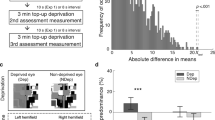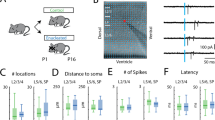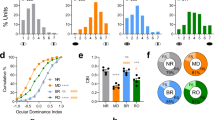Abstract
CATS deprived of visual experience in one eye during a critical period of early life develop marked changes in the functional organisation of their visual system1–3. Useful vision seems to be lost in the deprived eye, and neurophysiological studies reveal a loss of binocular input to neurones in the visual cortex. Most neurones fail to respond to stimuli presented to the deprived eye; whereas almost all respond to stimulation of the normal eye. In normal neonatal kittens without visual experience, most cortical neurones respond to stimulation of either eye. Moreover, this binocular neuronal input persists when subsequent visual experience is prevented by binocular lid suture. Thus, asymmetrical visual experience seems necessary to produce a loss of binocular input. This loss of functional input from the deprived eye could result from a loss of the normal excitatory synaptic connections or from inhibitory suppression of afferent input. We postulate that asymmetrical visual experience causes synaptic inhibition of input from the deprived eye and that reduction of such inhibition might restore binocularity.
This is a preview of subscription content, access via your institution
Access options
Subscribe to this journal
Receive 51 print issues and online access
$199.00 per year
only $3.90 per issue
Buy this article
- Purchase on Springer Link
- Instant access to full article PDF
Prices may be subject to local taxes which are calculated during checkout
Similar content being viewed by others
References
Wiesel, T. N., and Hubel, D. H., J. Neurophysiol., 28, 1029–1040 (1965).
Wiesel, T. N., and Hubel, D. H., J. Neurophysiol., 28, 1060–1072 (1965).
Barlow, H. B., Nature, 258, 199–204 (1975).
Curtis, D. R., and Johnson, G. A. R., Ergebn. Physiol., 69, 98–188 (1974).
Rose, D., and Blakemore, C., Nature, 249, 375–377 (1974).
Daniels, J. D., and Pettigrew, J. D., Brain Res., 93, 41–62 (1975).
Sillito, A. M., J. Physiol., Lond., 250, 287–304 (1975).
Sillito, A. M., J. Physiol., Lond., 250, 305–329 (1975).
Ikeda, H., and Wright, M. J., Expl Brain Res., 20, 471–484 (1974).
Hubel, D. H., and Wiesel, T. N., J. Physiol., Lond., 160, 106–154 (1962).
Hubel, D. H., and Wiesel, T. N., J. Neurophysiol., 28, 229–289 (1965).
Rose, D., and Blakemore, C., Expl Brain Res., 20, 1–17 (1974).
Chow, K. L., in Handbook of Sensory Physiology: Central Visual Information, A, 7/3 (edit. by Jung, R.), 599–627 (Springer, Berlin, Heidelberg, New York, 1973).
Creutzfeldt, O., and Ito, M., Expl Brain Res., 6, 324–352 (1968).
Benevento, L. A., Creutzfeldt, O. D., and Kuhnt, U., Nature new Biol., 238, 124–126 (1972).
Iversen, L. L., Mitchell, J. F., and Srinivasan, V., J. Physiol., Lond., 212, 519–534 (1971).
Wallingford, E., Ostdahl, R., Zarzecki, P., Kaufman, P., and Somjen, G., Nature new Biol., 242, 210–212 (1973).
Author information
Authors and Affiliations
Rights and permissions
About this article
Cite this article
DUFFY, F., SNODGRASS, S., BURCHFIEL, J. et al. Bicuculline reversal of deprivation amblyopia in the cat. Nature 260, 256–257 (1976). https://doi.org/10.1038/260256a0
Received:
Accepted:
Issue Date:
DOI: https://doi.org/10.1038/260256a0
This article is cited by
-
Inhibitory interneurons in visual cortical plasticity
Cellular and Molecular Life Sciences (2016)
-
Bidirectional plasticity in fast-spiking GABA circuits by visual experience
Nature (2009)
-
Potentiation of cortical inhibition by visual deprivation
Nature (2006)
-
Effect of visual deprivation on neurotransmitter receptor development in the rat visual system
Neurophysiology (1985)
Comments
By submitting a comment you agree to abide by our Terms and Community Guidelines. If you find something abusive or that does not comply with our terms or guidelines please flag it as inappropriate.



